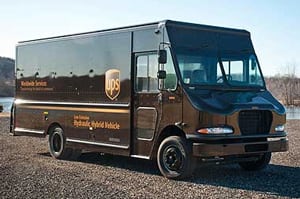 UPS reported second-quarter earnings that were ahead of analyst estimates, even though revenue was slightly below expectations, the latter hurt by the strong dollar and the continuing decline in fuel surcharges due to lower oil prices. Yields were helped on the pricing side by the annual general rate increase, new dimensional weight charges and other surcharges.
UPS reported second-quarter earnings that were ahead of analyst estimates, even though revenue was slightly below expectations, the latter hurt by the strong dollar and the continuing decline in fuel surcharges due to lower oil prices. Yields were helped on the pricing side by the annual general rate increase, new dimensional weight charges and other surcharges.
The company’s Q2 revenue was $14.1 billion, down 1.2% percent from 2014. The adjusted earnings per share figure was $1.35, well ahead of the analyst consensus of $1.26 per share; it was up 175% from 49 cents in the year-ago quarter. Revenue for UPS’s domestic package business was $8.81 billion, up 1.6% from $8.67 billion in 2014.
Asked about the slower than expected growth in the ground segment, UPS Chief Commercial Officer and Executive Vice President Alan Gershenhorn said the current period was up against a “tough comp” of 8% growth in 2014, adding it was up 9% overall since Q2 of 2013. He said the 2014 figure was also helped by a “very large catalog shipment.”
When asked if the slower than expected growth in B2C ground shipments was due to volume lost to competition, UPS executives blamed it on economic headwinds.
“If you just look at in January, the GDP forecast we thought was going to be about 3.1%,” said CEO David Abney. “Now, the thinking in July is about 2.3%, so let’s say that’s a pretty significant decrease. Retail has been uneven and we saw it soften a little bit in June.”
Concerning its B2B business, UPS executives said it was up in the quarter, helped along by strength in ecommerce, omnichannel and return services in the retail sector.
Gershenhorn said UPS is continuing to pursue peak season surcharges for some major retail shippers as a way to line up costs with service levels. This affects shipment of large parcels that the UPS network is not designed to handle on a regular basis.
“We are going to continue to address peak on a customer-by-customer basis, really understanding what their needs are, the value of the solutions and market conditions and price them accordingly,” he said. He also said UPS has “comprehensive peak pricing initiatives underway” to gain additional revenue from retailers who create costly, unexpected volume spikes during the holiday crush.
UPS has also signaled that it plans to hire fewer seasonal workers than last year, when it brought on 95,000 temporary employees. The prior year, UPS hired 80,000 temps during a holiday season in which a confluence of factors led to over 1 million package delays.
There will also be fewer UPS drivers on the road at peak this year, according to Myron Gray, president of U.S. operations for UPS. “We’re also going to … tighten up operations,” Gray said. “We’ll extend our drivers’ delivery day a bit and will not use as many drivers as we’ve used in the past to lower our costs.” Even with fewer drivers, he said UPS will increase peak throughput by 6%, through a combination of hub modernization, automation and expanded capacity projects.
Gershenhorn spoke to the effects of the recent Prime Day on July 15, which Amazon created as a way to drive Amazon Prime membership and boost sales during a flat period in the summer. Amazon said customers ordered 34.4 million items on Prime Day, at a rate of 398 items per second, eclipsing Black Friday records. It also said it signed up “hundreds of thousands” of new Prime members, which total an estimated 40 million worldwide.
“As we all know there was a number of retailers out there that had a number of similar events,” Gershenhorn said, referring to Walmart and others who joined the fray. “And we’re actually excited about this innovativeness that’s going to continue with e-commerce. It obviously drives significant small package growth and redefines how business is done. And UPS will benefit and continue to benefit from those type of promotions.”
Gershenhorn added UPS has the ability within its ecommerce operations to flex its network and “support those kind of promotions very cost-effectively.”
Abney refused to bite on an analyst question about speculation from Bloomberg that UPS is in talks with Coyote Logistics to acquire the Chicago-based company for $1.8 billion. But he then spoke to the company’s acquisition approach in general.
“First we ask, what are new opportunities that would allow us to expand our portfolio and allow us to give additional value to our customers?” Abney said. “We also look at geography, are there certain geographies that could strengthen our offering? And then third, we look at what capability does our network presently need that we don’t have? And where there’s an adjacent industry or whether it’s a different service offering.”
UPS has recently expanded its reach into the luxury goods market with the complementary acquisitions of Insured Parcel Services and Parcel Pro.
